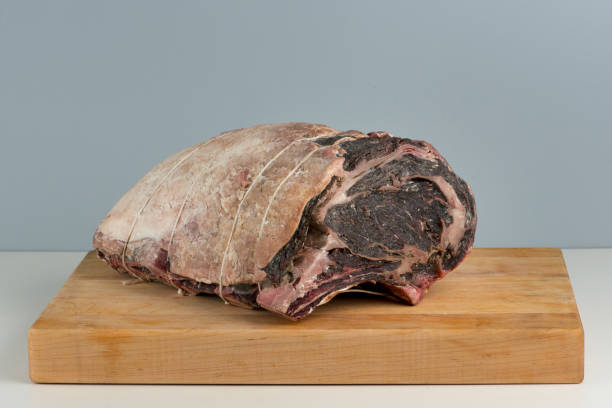The world of fine dining and steak aficionados is often characterized by an appreciation for the finer details of culinary craftsmanship. Among these details, one process stands out as the epitome of steak perfection: dry-aging. While many savor the exceptional taste and tenderness of a well-prepared steak, few truly understand the artistry behind dry-aging.
The Essence of Dry-Aging
Dry-aging is a method of aging beef that, at its core, seeks to intensify the flavors and tenderness of the meat. It’s a time-honored technique, often practiced in reputable steakhouses, that requires patience, precision, and an innate understanding of the science of meat. The process begins with selecting the finest cuts of beef, typically ribeye or sirloin, and then subjecting them to carefully controlled conditions.
Temperature and Humidity Control
The first step in the dry-aging process involves temperature and humidity control. The beef cuts are placed in a specially designed refrigeration unit known as a dry-aging cooler or chamber. These units maintain a consistent temperature just above freezing and precisely controlled humidity levels. The cold environment halts bacterial growth while promoting enzymatic activity, resulting in the breakdown of connective tissues.
The Magic of Enzymes
Enzymes play a pivotal role in the dry-aging process. As the beef ages in the controlled environment, enzymes naturally present in the meat begin to activate. Proteolytic enzymes, including cathepsins and calpains, initiate a complex series of reactions that break down proteins, collagen, and muscle fibers. This enzymatic activity gradually tenderizes the meat and enhances its flavor.
The Flavor Transformation
One of the most remarkable aspects of dry-aging is the transformation of flavor. As the beef ages, it undergoes a metamorphosis that evolves its taste from ordinary to extraordinary. During the aging process, the beef loses moisture through evaporation, concentrating the flavors and intensifying the umami, or savory, notes in the meat. The result is a depth of flavor that’s difficult to achieve through any other method.
The Role of Microbes
While dry-aging beef, microbes also play a subtle but essential role. In the controlled environment of the dry-aging chamber, beneficial lactic acid bacteria thrive, outcompeting harmful bacteria. This natural fermentation process helps to develop the characteristic nutty, earthy flavors found in well-aged steaks.
The Time Factor
The duration of dry-aging significantly influences the final product. Steakhouses often dry-age their beef for several weeks to several months. The length of aging is a delicate balance, as longer aging intensifies the flavors but requires precise temperature and humidity control to avoid spoilage.
The Art of Trimming
Once the dry-aging process is complete, the outer layer of the beef, known as the pellicle, becomes hard and desiccated. It’s crucial to remove this outer layer before cooking the meat. This meticulous trimming is a crucial step, as it reveals the beautifully marbled, intensely flavorful, and exceptionally tender interior of the steak.
The Culinary Craftsmanship
Dry-aging is a testament to the craftsmanship and dedication of culinary experts. It’s a process that combines science, artistry, and an unwavering commitment to excellence. The skill required to consistently produce perfectly dry-aged steaks is a testament to the mastery of the steakhouse’s kitchen.
The Result: Culinary Perfection
The culmination of the dry-aging process is culinary perfection. Dry-aged steaks are distinguished by their unparalleled flavor, tenderness, and marbling. They offer a dining experience that’s both robust and nuanced, with each bite revealing a symphony of flavors that tantalizes the palate.
Dry-Aged Steaks in Fine Dining
Fine dining establishments, especially steakhouses, have long embraced the tradition of dry-aging. Dry-aged steaks have become a hallmark of excellence in these establishments, where patrons expect nothing less than the finest quality.
The Science Behind Dry-Aging
The science behind dry-aging is an area of ongoing research and fascination. While the essential principles are understood, the specifics of the enzymatic reactions, microbial interactions, and flavor development continue to be subjects of study for scientists and culinary experts alike.
The Price of Perfection
Dry-aging, with its meticulous control of temperature, humidity, and time, is not without its costs. The process results in a loss of moisture and a reduction in weight, meaning that dry-aged steaks often come at a premium price. However, the investment is well worth it for those who seek an extraordinary dining experience.
The Culinary Journey
For those with a discerning palate and a love for steak, indulging in a dry-aged steak is a culinary journey worth embarking upon. The marriage of time, skill, and quality ingredients creates a dining experience that is nothing short of exceptional.
Dry-Aging at Home
While dry-aging is often left to the professionals, some adventurous home cooks have ventured into the world of DIY dry-aging. Specialized bags and dry-aging refrigerator units are available for purchase, allowing enthusiasts to experiment with the process in their own kitchens. However, it’s a challenging endeavor that requires precise control over the environment and a deep understanding of the science involved.
The Future of Dry-Aging
As culinary traditions evolve, so does the art of dry-aging. The future holds the promise of even more precise and innovative methods for aging meat, ensuring that dry-aged steaks will continue to be celebrated and savored by generations to come.
Dry-aging is a culinary alchemy that transforms ordinary cuts of beef into extraordinary dining experiences. It’s a fusion of science and artistry that results in steaks of unparalleled flavor, tenderness, and quality. For those who appreciate the finer details of culinary craftsmanship, dry-aged steaks are nothing less than a masterpiece on a plate.
